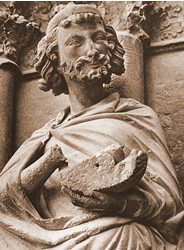 |
St
Joseph Rheims Cathedral |
Coming to his hometown, he began teaching the people in their synagogue, and they were amazed. “Where did this man get this wisdom and these miraculous powers?” they asked.
“Isn’t this the carpenter's son?” (Matthew 13:54-55)
As perhaps is fitting for the man who stood by Mary when she appeared to be pregnant with a child that wasn’t his, Joseph has been adopted as the patron saint of fathers. A man of humble means and occupation, he is also patron of workers, and—reflecting the fact that he did everything in his power to ensure the continued safety of Mary and her child—he is also considered to be the patron saint of the Church.
Saint Joseph—in Italian, San Giuseppe or San Giuse—is particularly beloved of Italians, a devotion that is said to date back to a time in the middle ages when there was a severe drought in Sicily. In desperation, the people turned to San Giuse, promising a big feast in his honour if he could intercede on their behalf. When rain arrived and it appeared that their prayers had been answered, huge banquet tables were set up for the poor, a tradition of gratitude and generosity that is still observed in many countries.
In some places villagers representing Jesus, Mary, and Joseph are guests of honour at a feast attended by the most needy segment of the community. In others, a special altar covered with food is set up in the church as a symbolic table; after the mass, the priest blesses the food to shouts of “Viva la tavola di San Giuse!”
Although the observance varies in different regions, the meal eaten on St Joseph’s day invariably includes minestrone or pasta served with breadcrumbs rather than cheese—the breadcrumbs symbolising the sawdust that would have covered the carpenter’s workshop—and fava beans, considered particularly lucky because at the time of the drought the fava thrived while other crops failed.